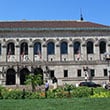Boston Public Library
Boston Public Library
Just across Boston’s Copley Square from H. H. Richardson’s Trinity Church sits another National Historic Landmark: the 1895 Boston Public Library building, designed by Charles Follen McKim of the New York firm of McKim, Mead & White.
Intended as a “palace for the people,” the granite Renaissance Revival building, with its grand architecture, cathedral-like reading halls, and lavish art collection, became an influential example of what a civic building could aspire to achieve.
Modeled in part after the Bibliothèque Sainte-Geneviève in Paris and other European public buildings, the building celebrated Beaux-Arts style, furthering a neoclassical aesthetic for public structures in America. (When the McKim building was designated by the National Park Service as a National Historic Landmark in 1986, it was described as “the first outstanding example of Renaissance Beaux-Arts Classicism in America.”)
Inside, murals by John Singer Sargent and sculptures by other notable American artists make the library a destination for art lovers. This artist-architect collaboration (seen also in Trinity Church) became a model for other civic buildings in the decades to come.
A 1972 addition by architect Philip Johnson further sealed the Boston Public Library’s reputation as an important architectural achievement.









